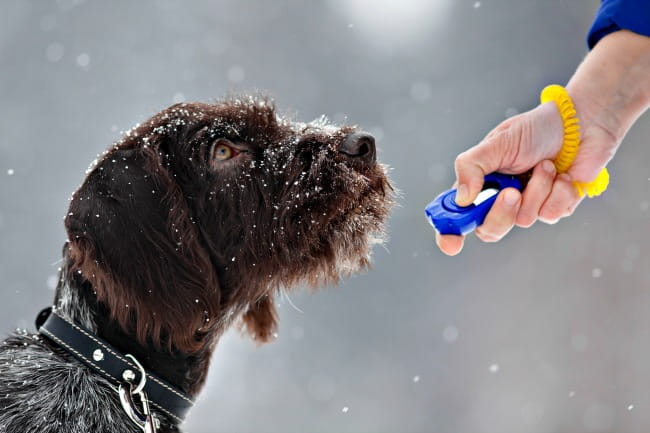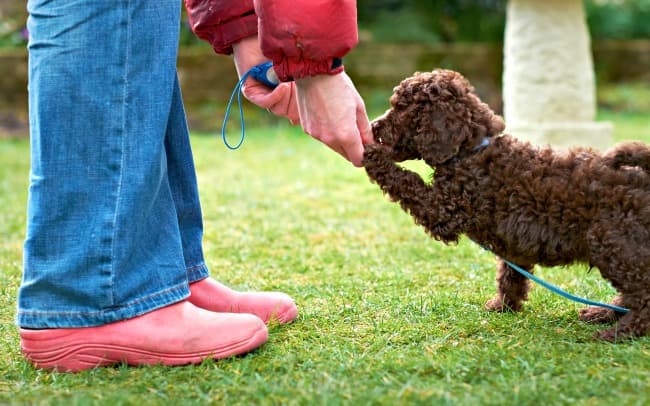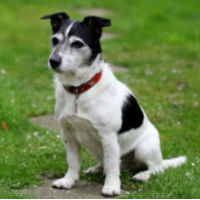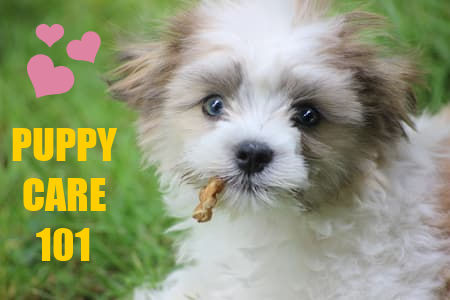FYI: If you buy something through a link on this site I may earn a commission - at NO extra cost to you.
All About Puppy Clicker Training
Puppy clicker training is relatively new, but it's quickly become very popular - and with good reason. It's simple, fun and very effective.
This technique is based on the use of a small, hand-held 'noise-maker' called a clicker, which makes a sharp 'click' when you press a button, or a metal strip.
You
can 'clicker train' dogs of all ages.... and it works equally well to
to teach simple manners, basic or advanced obedience, and even fancy dog
tricks.
You can 'shape' the behavior you want or curb unwanted behavior in a positive, reward-oriented way... and spend some 'bonding' time with your pet at the same time.
This method was first used to train Dolphins, and it works with many different types of animals including birds and horses.

Quick Links:
Clicker Basics
When it comes to clicker dog training, the most important thing to get right is the timing of the 'click'. This is because the 'click' is immediately followed by a reward/treat and is designed to let little Fido know that he's done something that makes you happy!
At first, you will be 'clicking and treating' for any desirable behavior you see - such as when your puppy sits down, lays down quietly, comes to you when you call his name etc.
It's important that you only 'click' during the required behavior, not after it's completed.
For example if you're teaching the 'sit' command, click and treat the second your pup's butt begins to touch the floor, not when he's in a complete sit.
This is because you want to make it clear to him that the behavior he's engaging in right now, is what you're rewarding him for. Puppies learn by association and he needs to make the RIGHT association from the very beginning.
As you get more experienced with this training technique, you'll be able to use a vocal cue such as "sit" or "down", and then by 'clicking and rewarding' when your puppy follows your instructions you'll beef-up those cause-and-effect associations.
You'll surprised how quickly your pup understands what's happening and how eager he is to please you.
Step-By-Step Guide To Clicker Training
There are a few simple steps to follow to make sure that you get started off on the right foot - and paw.
Puppies are creatures of habit, and they're also like little sponges and learn very fast.
If they learn the 'wrong' thing first time around, or build a bad habit, it can be challenging to convince them that they need to do things a different way!

Luckily using a clicker isn't complicated, and if you follow the steps outlined here you won't have any problems getting it right.
'Loading The Clicker'
To start your puppy clicker training off in the right way, you need to 'load' the clicker - this is how you teach your puppy that the 'click' means something good...a treat!
Load the clicker by 'clicking and treating' 10 - 12 times in quick succession without asking your puppy for any specific behavior.
Just click and treat! At this point the treats are 'freebies' and you're just aiming to have your pet associate the noise with a treat. End the session after a dozen or so click-and-treats.
Clicker Training For Basic Obedience
You can teach your puppy all the basic obedience commands such as 'Sit', 'Down', 'Stay', 'Leave It' and so on.
The process is the same for each one, so let's take a look at the simplest (and usually the first) command, the 'Sit'........
- Begin by trying to catch your pup in the act of sitting down and 'capture' this behavior by 'clicking and treating' as he's in the process of sitting down.
- Remember to click and treat the second his little booty hits the floor! 3 or 4 repetitions is enough per training session to begin with, and 3 or 4 sessions a day works well.
- Once you've practiced like this for a while, and you're sure your little one understands the connection between his sitting and the click
and treat, you can begin to use verbal cues.
- Get his attention and then say "sit" in a firm but friendly way,
as soon as his little butt begins to touch the floor, click and treat
and say "good sit".
- Use the same puppy clicker training process for any command you want to teach your puppy. Remember though that puppies have very short attention spans, so keep the sessions short and always end on a positive not (ie. when he's been successful).
Never use the clicker for anything except your puppy clicker training sessions, as using it as a toy or in any other situation will only confuse your little furchild.
Eventually (maybe after several weeks, or longer) you'll find your pup is very consistent and reliable in obeying your instructions. At that point you can start to treat intermittently rather than every time he does what you want. You'll still need to click every time though!
By only treating every second, or every third time you help prevent him from getting totally 'food focused' and keep him on his toes, as he never knows which time he'll get his reward!
Clicker training is really simple and your pup will 'get it' quickly. To help YOU 'get it', here's a short video that shows you how to apply the principles of this style of dog training.
You can use the puppy clicker training method to teach all kinds of dog obedience commands, behavior and tricks (including agility training). You can also use it to train other animals such as cats or birds.
Training your puppy should be a fun and rewarding experience for both of you, and puppy clicker training makes this possible. It's a great way to help build a strong and trusting relationship between you and your puppy.
With puppy clicker training you can raise the happiest, healthiest, best behaved dog you could ever hope for!
Clickers, pouches and treats galore!
There are tons of different clickers on the market, and they all do the same thing, so which one you choose is mostly down to personal taste!
One thing I would recommend is having several clickers because they have a tendency to get lost, and I also like to have them in different rooms (plus at least one in the car) so that when a teachable moment, or impromptu training sessions, happens we're ready to go!
If you're going to be out and about when training your pup/dog, then a clicker with a wrist strap is a good choice. Or you can attach one to a lanyard or use a carabiner and clip it onto your belt.
Here are a few options that you might want to check out:
Starmark Pro Training Clickers (pack of three) - Simple design, sharp 'click', robust and easy to use. Often favored by dog training pros, this is a solid, basic clicker that gets the job done.
EcoCity Dog Training Clickers - pack of four brightly colored clickers with wrist straps. Click is a little more muted than with the Starmark Pro but some owners prefer this, and your pup's hearing is way better than yours so he has no problem with it!
Coolrunner Dog Training Clickers - pack of seven colorful clickers with wrist straps. Size, shape and raised button makes them super easy to hold, and use. Great value for money here.
Obviously when you're clicker training your puppy or dog, you also want to have some tiny, tasty treats on hand, so you can 'click-the-treat' instantly. Treats need to be small and preferably low calorie, because Fido is probably going to eat a LOT of them.
Having those treats in a dog treat pouch clipped to your belt or belt loops, or in a fanny pack, keeps them close at hand. Again, there are many different options to choose from. Fabric, silicone, zippers, magnetic closures.... again personal taste rules.
Here are just three of the different options for treat pouches:
ChuckIt! Treat Tote - perfect size for a handful of treats without being bulky or getting in your way. Handy clip lets you attach it to belt, waistband, clothing etc. Easy to open and close with simple drawstring. Water resistant fabric, with rip stop lining. This is a basic, no frills treat tote, and that's just fine :)
Paw Lifestyles Dog Treat Training Pouch - there are a few more frills with this pouch, including a built-in poop bag holder, extra zippered pouches which are handy for keys, phone etc., plus three ways to carry it (shoulder strap, waist band or belt clip). Made from lightweight, weatherproof nylon with a drawstring closure.
AUDWUD BPA-free Silicone Dog Treat Pouch - small, sturdy, easy to clean (it's even dishwasher safe) dog treat pouch available in several bright colors. Wide opening with magnet closure and a sturdy clip means this can be attached to belt, waistband or pocket.
The perfect treats for clicker training are small, tasty and low calorie. Freeze-dried meat treats fit this bill perfectly and my dogs really like Pupford freeze dried training treats, the beef liver is their favorite but you can also choose from chicken, rabbit, salmon and sweet potato flavors.
For peanut butter loving pooches, Bixbi peanut butter training treats are a great choice. This brand also has chicken, salmon and bacon flavors to choose from.
Gluten free options include Merrick's Power Bites and Nulo grain free training rewards.
you might also like...
- Home
- Puppy Training Basics
- Puppy Clicker Training
FTC Disclosure: Some pages on this site contain affiliate links. I may earn on qualified purchases.





